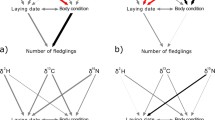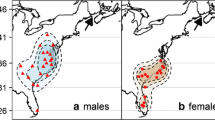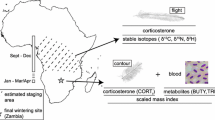Abstract
Winter habitat use can influence the breeding success of migratory songbirds in temperate regions due to its impact on bird condition and breeding phenology. How such carry-over effects vary with latitude is unknown. To address this question, we examined how winter habitat use, inferred from δ13C and δ15N signatures in winter-grown feathers, influenced the breeding phenology and productivity of Yellow Warblers (Setophaga petechia) at the extreme north of their range in the Canadian arctic (68°N) and compared this population with midlatitude Yellow Warbler (51°N) and American Redstart (Setophaga ruticilla; 44°N) populations reported in previous studies. In the arctic, we examined male arrival dates, female clutch initiation dates and the relationship between these timing variables and the number and quality of offspring produced within the season. In contrast to warblers breeding at midlatitudes, we find no support for an impact of winter habitat use on breeding phenology or productivity. Male arrival dates and female clutch initiation dates in both young and older individuals were not correlated with isotopic signatures acquired on the wintering grounds. Males with enriched δ15N signatures paired more rapidly after arrival, indicating a possible relationship between winter habitat use and condition. This relationship did not enhance annual productivity for these individuals, however, as the negative relationship between breeding phenology and reproductive success in our arctic population was significantly weaker than among Yellow Warblers breeding further south. This reduction or absence of timing effects on productivity in the north effectively removes one pathway through which carry-over effects can act.




Similar content being viewed by others
References
Amundson R, Austin AT, Schuur EAG, Yoo K, Matzek V, Kendall C, Uebersax A, Brenner D, Baisden WT (2003) Global patterns of the isotopic composition of soil and plant nitrogen. Global Biogeochem Cycles 17:1031–1041. doi:200310.1029/2002GB001903
Bearhop S, Hilton GM, Votier SC, Waldron S (2004) Stable isotope ratios indicate that body condition in migrating passerines is influenced by winter habitat. Proc R Soc B Biol Sci 271:S215–S218. doi:10.1098/rsbl.0129
Binford LC (1989) A distributional survey of the birds of the Mexican state of Oaxaca. Ornithol Monogr 43:392–418
Boulet M, Gibbs HL, Hobson KA (2006) Integrated analysis of genetic, stable isotope, and banding data reveal migratory connectivity and flyways in the northern Yellow Warbler (Dendroica petechia; Aestiva Group). Ornithol Monogr 61:29–78. doi:10.2307/40166837
Brown WP, Roth RR (2002) Temporal patterns of fitness and survival in the Wood Thrush. Ecology 83:958–969. doi:10.2307/3071905
Croll DA, Maron JL, Estes JA, Danner EM, Byrd GV (2005) Introduced predators transform subarctic islands from grassland to tundra. Science 307:1959–1961. doi:10.1126/science.1108485
Currie DJ, Fritz JT (1993) Global patterns of animal abundance and species energy use. Oikos 67:56–68. doi:10.2307/3545095
Drake A, Rock C, Quinlan SP, Green DJ (2013) Carry-over effects of winter habitat vary with age and sex in Yellow Warblers (Setophaga petechia). J Avian Biol 44:321–330. doi:10.1111/j.1600-048X.2013.05828.x
Dunn J, Garrett K (1997) A field guide to warblers of North America. Houghton Mifflin Harcourt, MA
Ebbinge BS, Spaans B (1995) The importance of body reserves accumulated in spring staging areas in the temperate zone for breeding in Dark-Bellied Brent Geese Branta b. bernicla in the high arctic. J Avian Biol 26:105–113. doi:10.2307/3677058
Environment Canada (2012) National climate data and information archive. www.climate.weatheroffice.gc.ca/climateData. Accessed Dec 2012
Faul F, Erdfelder E, Lang AG, Buchner A (2007) G*Power 3: a flexible statistical power analysis program for the social, behavioral, and biomedical sciences. Behav Res Methods 39:175–191. doi:10.3758/BF03193146
Gill D (1973) Ecological modifications caused by the removal of tree and shrub canopies in the Mackenzie Delta. Arctic 26:95–111
Gottlander K (1987) Variation in the song rate of the male Pied Flycatcher Ficedula hypoleuca: causes and consequences. Anim Behav 35:1037–1043. doi:10.1016/S0003-3472(87)80160-4
Greenberg R, Salgado-Ortiz J (1994) Interspecific defense of pasture trees by wintering Yellow Warblers. Auk 111:672–682
Greenberg R, Reitsma R, Angon AC (1996) Interspecific aggression by Yellow Warblers in a sun coffee plantation. Condor 98:640–642. doi:10.2307/1369579
Gunnarsson TG, Gill JA, Newton J, Potts PM, Sutherland WJ (2005) Seasonal matching of habitat quality and fitness in a migratory bird. Proc R Soc B Biol Sci 272:2319–2323. doi:10.1098/rspb 2005.3214
Hannah L, Carr JL, Lankerani A (1995) Human disturbance and natural habitat: a biome level analysis of a global data set. Biodivers Conserv 4:128–155. doi:10.1007/BF00137781
Hendricks P (1997) Geographical trends in clutch size: a range-wide relationship with laying date in American Pipits. Auk 114:773–778. doi:10.2307/4089300
Hobson KA (1999a) Tracing origins and migration of wildlife using stable isotopes: a review. Oecologia 120:314–326. doi:10.1007/s004420050865
Hobson KA (1999b) Stable-carbon and nitrogen isotope ratios of songbird feathers grown in two terrestrial biomes: implications for evaluating trophic relationships and breeding origins. Condor 101:799–805. doi:10.2307/1370067
Hobson KA (2007) Isotopic tracking of migrant wildlife. In: Michener RH, Lajtha K (eds) Stable isotopes in ecology and environmental science, 2nd edn. Wiley, MA, pp 155–175
Hobson KA, Alisauskas RT, Clark RG (1993) Stable-nitrogen isotope enrichment in avian tissues due to fasting and nutritional stress: implications for isotopic analyses of diet. Condor 95:388–394. doi:10.2307/1369361
Hobson KA, Barnett-Johnson R, Thure C (2010) Using isoscapes to track animal migration. In: West JB et al. (eds) Isoscapes: understanding movement, pattern, and process on Earth through isotope mapping. Springer, NY pp 273–298. doi:10.007/978-90-481-3354-3
Kelly JF (2000) Stable isotopes of carbon and nitrogen in the study of avian and mammalian trophic ecology. Can J Zool 78:1–27. doi:10.1139/z99-165
Latta SC, Faaborg J (2002) Demographic and population responses of Cape May Warblers wintering in multiple habitats. Ecology 83:2502–2515. doi:10.2307/3071810
Legagneux P, Fast PLF, Gauthier G, Bêty J (2011) Manipulating individual state during migration provides evidence for carry-over effects modulated by environmental conditions. Proc R Soc B Biol Sci 279:876–883. doi:10.1098/rspb.2011.1351
Lowther PE, Celada C, Klein NK, Rimmer CC, Spector DA (1999) Yellow Warbler (Dendroica petechia). In: Poole A, Gill F (eds) The birds of North America Online. doi:10.2173/bna.454. Accessed June–Aug 2012
Lozano GA, Perreault S, Lemon RE (1996) Age, arrival date and reproductive success of male American Redstarts Setophaga ruticilla. J Avian Biol 27:164–170. doi:10.2307/3677146
Magrath RD (1991) Nestling weight and juvenile survival in the Blackbird, Turdus merula. J Anim Ecol 60:335–351. doi:10.2307/5464
Mainguy J, Bêty J, Gauthier G, Giroux J-F (2002) Is the body condition of laying greater snow geese and their reproduction affected by the spring conservation hunt? Condor 104:156–161
Marra PP (2012) Studying birds in the context of the annual cycle: carry-over effects and seasonal interactions. Presented at the North American Ornithological Conference, Vancouver, British Columbia
Marra PP, Hobson KA, Holmes RT (1998) Linking winter and summer events in a migratory bird by using stable-carbon isotopes. Science 282:1884–1886. doi:10.1126/science.282 5395.1884
Martin M (2013) Latitudinal variation in life history traits and incubation patterns in Yellow Warblers. Simon Fraser University
Martin K, Wiebe KL (2004) Coping mechanisms of alpine and arctic breeding birds: extreme weather and limitations to reproductive resilience. Integr Comp Biol 44:177–185. doi:10.1093/icb/44.2.177
Mazerolle DF, Daniel F, Dufour KW, Hobson KA, den Haan HE (2005) Effects of large-scale climatic fluctuations on survival and production of young in a neotropical migrant songbird, the Yellow Warbler Dendroica petechia. J Avian Biol 36:155–163. doi:10.1111/j.0908-8857.2005.03289.x
McKinnon L, Smith PA, Nol E, Martin JL, Doyle FI, Abraham KF, Gilchrist HG, Morrison RIG, Bêty J (2010) Lower predation risk for migratory birds at high latitudes. Science 327:326–327. doi:10.1126/science.1183010
Newton I (2008) The migration ecology of birds. Academic Press, London
Norris DR, Marra PP, Kyser TK, Sherry TW, Ratcliffe LM (2004) Tropical winter habitat limits reproductive success on the temperate breeding grounds in a migratory bird. Proc R Soc B Biol Sci 271:59–64. doi:10.1098/rspb.2003.2569
Post DM (2002) Using stable isotopes to estimate trophic position: models, methods, and assumptions. Ecology 83:703–718. doi:10.2307/3071875
Pyle P (1997) Identification guide to North American birds, Part I: Columbidae to Ploceidae. Slate Creek Press, CA
Quinlan SP, Green DJ (2010) Variation in deuterium (δD) signatures of Yellow Warbler Dendroica petechia feathers grown on breeding and wintering grounds. J Ornithol 152:93–101. doi:10.1007/s10336-010-0553-5
Reudink MW, Marra PP, Kyser TK, Boag PT, Langin KM, Ratcliffe LM (2009) Non-breeding season events influence sexual selection in a long-distance migratory bird. Proc R Soc B Biol Sci 276:1619–1626. doi:10.1098/rspb.2008.1452
Rockwell SM, Bocetti CI, Marra PP (2012) Carry-over effects of winter climate on spring arrival date and reproductive success in an endangered migratory bird, Kirtland’s Warbler (Setophaga kirtlandii). Auk 129:744–752. doi:10.1525/auk.2012.12003
Saino N, Szép T, Ambrosini R, Romano M, Møller AP (2004) Ecological conditions during winter affect sexual selection and breeding in a migratory bird. Proc R Soc B Biol Sci 271:681–686. doi:10.1098/rspb 2003.2656
Salgado-Ortiz J, Marra PP, Sillett TS, Robertson RJ (2008) Breeding ecology of the Mangrove Warbler (Dendroica petechia bryanti) and comparative life history of the Yellow Warbler subspecies complex. Auk 125:402–410. doi:10.1525/auk.2008.07012
Sandberg R (1996) Fat reserves of migrating passerines at arrival on the breeding grounds in Swedish Lapland. Ibis 138:514–524. doi:10.1111/j.1474-919X.1996.tb08072.x
Sandberg R, Moore FR (1996) Fat stores and arrival on the breeding grounds: reproductive consequences for passerine migrants. Oikos 77:577–581. doi:10.2307/3545949
Sherry TW, Holmes RT (1996) Winter habitat quality, population limitation, and conservation of neotropical-nearctic migrant birds. Ecology 77:36–48. doi:10.2307/2265652
Smith RJ, Moore FR (2003) Arrival fat and reproductive performance in a long-distance passerine migrant. Oecologia 134:325–331. doi:10.1007/s00442-002-1152-9
Smith RJ, Moore FR (2005) Arrival timing and seasonal reproductive performance in a long-distance migratory landbird. Behav Ecol Sociobiol 57:231–239. doi:10.1007/s00265-004-0855-9
Smith JAM, Reitsma LR, Marra PP (2010) Moisture as a determinant of habitat quality for a nonbreeding neotropical migratory songbird. Ecology 91:2874–2882. doi:10.1890/09-2212.1
Smith JAM, Reitsma LR, Marra PP (2011) Multiple space-use strategies and their divergent consequences in a nonbreeding migratory bird (Parkesia noveboracensis). Auk 128:53–60. doi:10.1525/auk.2011.10241
Studd MV, Robertson RJ (1985) Evidence for reliable badges of status in territorial Yellow Warblers (Dendroica petechia). Anim Behav 33:1102–1113. doi:10.1016/S0003-3472(85)80169-X
Studds CE, Marra PP (2005) Nonbreeding habitat occupancy and population processes: an upgrade experiment with a migratory bird. Ecology 86:2380–2385. doi:10.1890/04-1145
Tulp I, Schekkerman H (2008) Has prey availability for arctic birds advanced with climate change? Hindcasting the abundance of tundra arthropods using weather and seasonal variation. Arctic 61:48–60
Wikelski M, Tarlow EM, Raim A, Diehl RH, Larkin RP, Visser GH (2003) Avian metabolism: costs of migration in free-flying songbirds. Nature 423:704. doi:10.1038/423704a
Yezerinac SM, Weatherhead PJ (1997) Extra–pair mating, male plumage coloration and sexual selection in Yellow Warblers (Dendroica petechia). Proc R Soc B Biol Sci 264:527–532. doi:10.1098/rspb.1997.0075
Acknowledgments
We thank the Nihtat Gwich’in Renewable Resource Council, the Inuvik Hunters and Trappers Committee and the Inuvik Town Council for their approval to work in the Inuvik area. The Aurora Research Institute and J. Ingram and B. Bartzen at Environment Canada provided local knowledge, technical and administrative support. We thank the Inuvik field team: S. Topp, M. Pennell and S. James, and our laboratory assistants: K. Hunter and G. Pang. Fieldwork was supported by Northern Studies Training Program (NSTP) Grants (2009–2011) to A. Drake and M. Martin, a Natural Sciences and Engineering Research Council of Canada (NSERC) Discovery grant to D.J. Green, and in-kind support from Environment Canada. A. Drake was supported by an NSERC CGS-D. M. Martin was supported by NSERC PGS-M. We thank D. Lank, P. Marra, W. Palen, R. Ydenberg and three anonymous reviewers for constructive feedback on the original manuscript.
Author information
Authors and Affiliations
Corresponding author
Rights and permissions
About this article
Cite this article
Drake, A., Martin, M. & Green, D.J. Winter habitat use does not influence spring arrival dates or the reproductive success of Yellow Warblers breeding in the arctic. Polar Biol 37, 181–191 (2014). https://doi.org/10.1007/s00300-013-1421-6
Received:
Revised:
Accepted:
Published:
Issue Date:
DOI: https://doi.org/10.1007/s00300-013-1421-6




